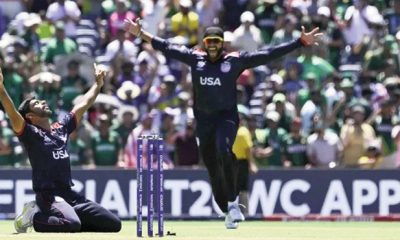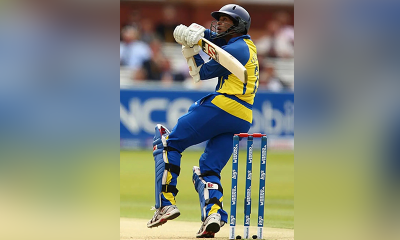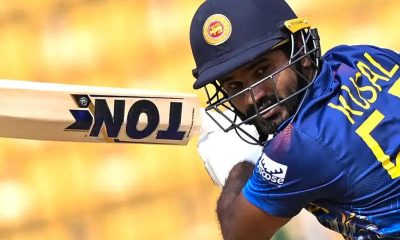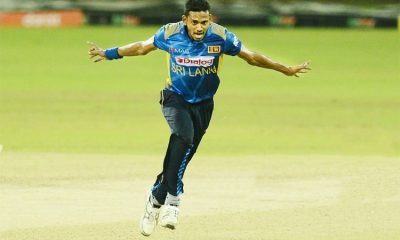Sports
We have to dissect this – Silverwood on Sri Lanka’s ‘inconsistent’ campaign
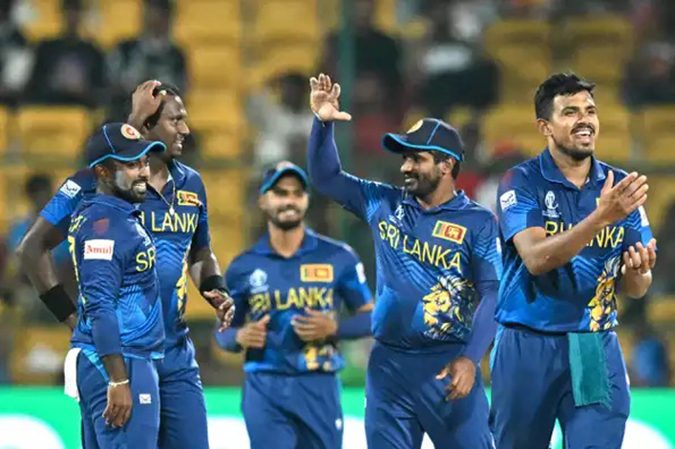
Bangalore’s November rain, predicted and promised, never came to hamper the clash at the Chinnaswamy Stadium Yet, Sri Lanka sank. And with them, also sank the hopes of their Asian counterparts – Afghanistan and Pakistan, unintentionally invoking the spirit of Gulbadin Naib 2019. “Hum to doobe hai sanam, tum ko bhi lekar doobenge” (If I’m going down, I’ll take you with me).
On Thursday, their challenge wasn’t blown away the way it was against India in the Asia Cup final. Not by an inspired bowling spell by the opposition in helpful conditions, but by a more uninspired batting performance of their own. There were patches of dominance when Kusal Perera took the attack to the New Zealanders early on. There were patches of fight with both bat and ball, but too late to repair much of the early damage. But the momentum – on a pitch that was much slower and vastly different from the one offered in the previous game at the same venue – never swung their way.
Such was the enormity of the context of this one contest, that its result eventually impacted the fortunes of four teams in the tournament. As it stands now, New Zealand are almost through to the semifinals, and Pakistan and Afghanistan are almost out. All this while Sri Lanka have their hopes of qualifying for the 2025 Champions Trophy in the hands of four other teams who will be competing over the next couple of days.
There have been better days in Sri Lankan cricket, and there will be many more better days in the future. But Thursday wasn’t one of those. It was, if anything, a disappointing culmination of a forgettable tournament that was far removed from the performances of the same team a couple of months ago. At the moment, head coach Chris Silverwood isn’t in a position to reflect on the team’s performance at the World Cup. He was hesitant to even open up about the possible positive takeaways from it.
“We have to let the emotions settle at the moment, we have to dissect this,” Silverwood said following Sri Lanka’s loss against New Zealand in their last league game of the tournament. “We have to have a very good debrief and dig deep into what has worked and what hasn’t worked and then try and plan that way forward obviously for the next cycle.
“They’re the positives that we need to take from this now, is how do we best prepare the boys and the generations that are coming through to actually compete in the next World Cup and make sure that come that World Cup, we are competing and we’re ready.”
At the Asia Cup, in home conditions, they seemed to have had most of their bases covered despite the absence of a few key players. While injuries, the turmoil in the board, the captain leaving the team mid-way and the Timed Out controversy would’ve likely played a part in impacting the team in India, their on-field performances left a lot wanting.
Skills-wise, Sri Lanka are far from the team that turned up for the World Cup, as evidenced by their Asia Cup performance where they reached the final. Silverwood pinned the poor performance down to ‘inconsistency’.
“I think it would be fair to use that word.”
He further added, “We’ve played some good cricket along the way, and I think we’ll look back on certain games and rue missed opportunities, to be honest. There have been certain games during this campaign that if we’d have taken the opportunities that were put our way, this could have looked a lot different. But the fact is that we have been inconsistent and it’s something that we’ve been working on for a long time and something we need to continue working on. So, yeah, I think inconsistent is a word we can use.”
To begin with, their strength – the spin attack – was blunted, eventually ending the tournament with the worst returns among all teams. While Wanindu Hasaranga’s injury would’ve played a part, Maheesh Theekshana, Dushan Hemantha and Dunith Wellalage – to go with the part-time options of Charith Asalanka and Dhananjaya de Silva – couldn’t pose enough of a threat.
Theekshana, who had picked 31 wickets in 15 games at an average of 17.45 in 2023, ended up picking only six wickets at an average of 63.66 in the World Cup. Dunith Wellalage, who had emerged as the breakthrough young star in the Asia Cup, picked up only two wickets at an average of 98 in India.
On the batting front, while Sadeera Samarawickrama and Pathum Nissanka had a fairly successful tournament, the team rarely clicked as a unit. The second opener’s slot was never sealed, and their in-form batter Kusal Mendis fizzled after starting with a century and a fifty in. Angelo Mathews, who joined the team mid-way, couldn’t give its batting a facelift.
Silverwood admitted that there is a long-term issue to fix with respect to the collapse of the batters. “It’s happened a couple of times now, a few times,” he admitted. “And it’s something that certainly during the debrief, when we get back and when we dissect what’s happened in this tournament, it’s something that we have to look at and we have to find some answers because clearly, we need to start putting runs on the board on good wickets and putting other teams under pressure. And we haven’t done that.”
Fielding remained a major concern, with as many as 10 catches dropped in the tournament. Even as the fielding coach Anton Roux believes seven of those were half chances missed, even as it’s unlikely that more successful teams have afforded to let go of those opportunities.
Silverwood wasn’t defending the fielding effort of his team and said, “It’s frustrating because certain catches that we’ve put down during this tournament have cost us heavily. It’s again something that we’re constantly working on. Our fielding coach is constantly working on that and trying to obviously push the standards higher. But clearly, there’s still work to be done as well. We are getting ourselves in positions where there’s more catches coming our way. We’ve been brave and going for half chances more, but clearly, we have to start hanging on to these if we want to start turning games in our favour.”
It’s been a collapse on all fronts. Sri Lanka came up second best in all aspects of the game for long periods of their time on the field. Now languishing second last on the points table – a reflection of their performance at the World Cup more than the available skill – they would hope that the only option going ahead after the World Cup is to go up, for the gloomy clouds to make way for the sun. Much like it did figuratively, and unexpectedly, at Chinnaswamy on Thursday.
(Cricbuzz)
Sports
England face Australia in the battle of champions
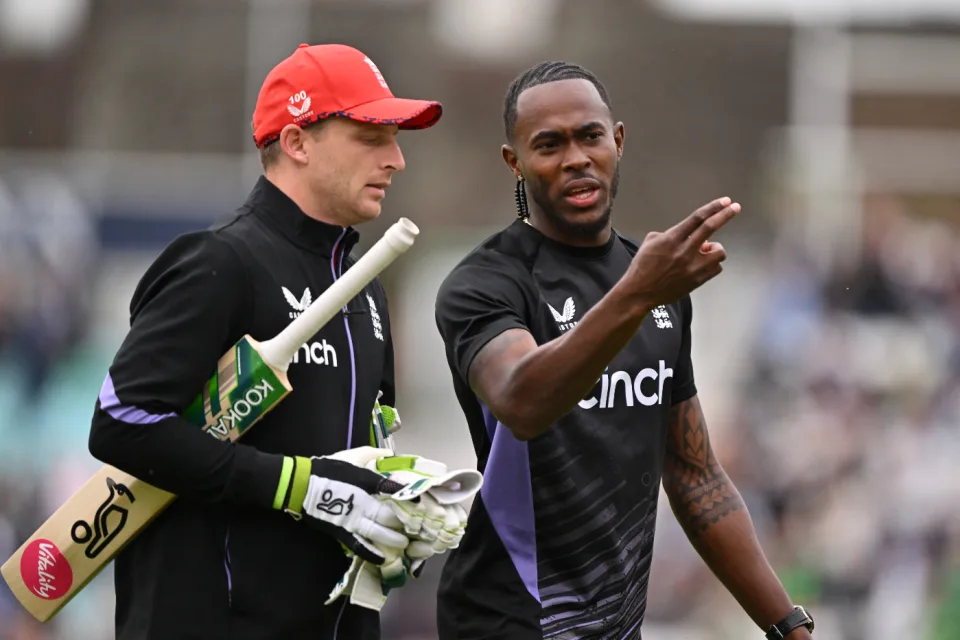
The first truly heavyweight clash of this expanded T20 World Cup format comes freighted with both history and subplots. A rematch of the 2010 World T20 final at Kensington Oval, the match pits Jos Buttler’s defending champions – who are aiming to become the first team to retain the trophy – against the Australian winning machine, victors at the 2021 edition and current world title-holders in Test and ODI cricket. And that’s before you throw in the Ashes for afters.
Already there is added pressure on England, after the rain in Bridgetown led to a share of the points in their opener against Scotland (and that having conceded 90 runs from 10 overs without taking a wicket in a tepid bowling display). Lose to their oldest rivals and it will leave their Super 8 prospects open to being waylaid by the perils of net run-rate calculations, or worse.
The Scotland match was the third abandonment in five suffered by England, after a rain-affected home series against Pakistan, which has clearly hampered their readiness for this campaign after almost six months without playing T20 together. It does not take much for a side to click in this format – and England looked in decent shape when they did get on the field against Pakistan – but Buttler will be anxious for things to go their way on Saturday, if only to avoid further questions referencing the team’s disastrous ODI World Cup defence last year.
Australia, under the laidback leadership of Mitchell Marsh would love nothing more than to add to the English sense of jeopardy – having helped bundle them out of the tournament in India on the way to taking the crown. Their head to head record is less impressive in T20 however, with England having won six of the last seven completed encounters, as well as that 2010 final.
Despite a wobble with the bat, Australia avoided mishap against Oman earlier in the week, the experience of David Warner and Marcus Stoinis shining through in difficult batting conditions. Surfaces in the Caribbean – not to mention those games staged in the USA – have already had teams scratching their heads; rather than the “slug-fest” England had prepared for, following a high-scoring tour of the Caribbean in December, it looks as if boxing smart may be the way to go.
Speaking of Warner, this could be the last time he faces up against England in national colours – and another match-winning contribution would likely reduce the chances of them meeting again in the knockouts. On the other side of the card is Jofra Archer, fresh from an emotional maiden outing at Kensington Oval and ready to take on Australia for the first time in any format since 2020. Can Mark Wood fire up England’s campaign, as he did during last summer’s Ashes? Will Pat Cummins be back to harass the old enemy once again? Seconds out, it’s almost time to rumble.
Cummins is set to return after being rested for the Oman game, which saw Mitchell Starc leave the field with cramp. Starc is understood to be fine and could keep his place – which would likely see Nathan Ellis miss out. Marsh is still not fit to bowl, with Australia likely to continue with the allrounder combination of Stoinis and Maxwell to give them cover.
Australia (probable XI): David Warner, Travis Head, Mitchell Marsh (capt), Glenn Maxwell, Marcus Stoinis, Josh Inglis (wk), Tim David, Pat Cummins, Nathan Ellis/Mitchell Starc, Adam Zampa, Josh Hazlewood
The one change England may consider is Reece Topley coming in for Wood, with the expectation that there will be some rotation among the seamers through the course of the tournament.
England (probable XI): Phil Salt, Jos Buttler (capt & wk), Will Jacks, Jonny Bairstow, Harry Brook, Liam Livingstone, Moeen Ali, Chris Jordan, Jofra Archer, Adil Rashid, Reece Topley/Mark Wood
[Cricinfo]
Sports
South Africa up against their bogey team in batter-unfriendly New York
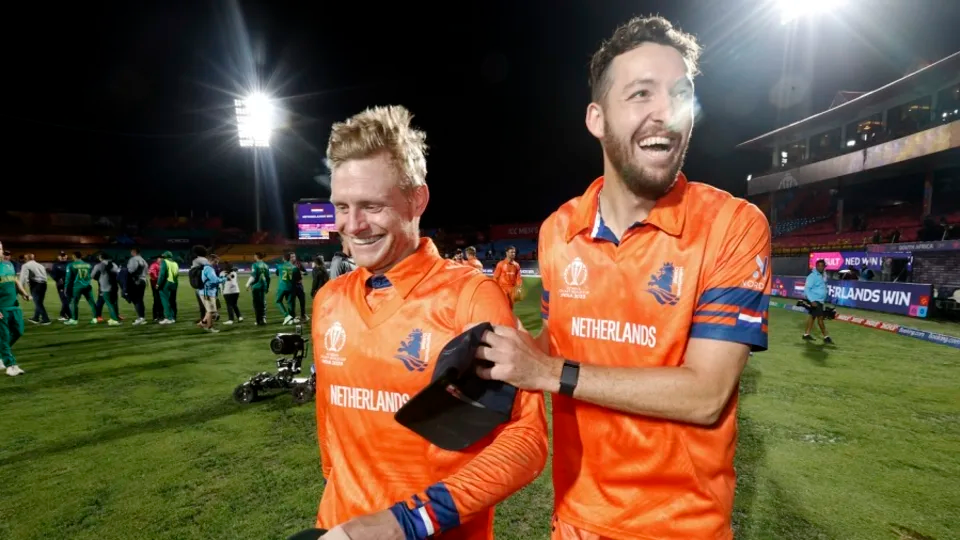
Once is coincidence, twice is a clue, and three times is proof.
To paraphrase Agatha Christie, that is the narrative around South Africa’s meeting with Netherlands at this T20 World Cup.
The Dutch beat South Africa at the 2022 tournament and ended their semi-final hopes in a match where South Africa appeared to be sleep walking, and then beat them again at the 2023 ODI World Cup, where they exposed South Africa’s vulnerability in the chase. If they to do the treble, not only will Netherlands take the lead in Group D, but they will offer conclusive evidence of the threat they pose to Full Members, especially South Africa.
Of course, it will take some doing after South Africa’s opening performance against Sri Lanka, where they reduced their opposition to their lowest T20I total and chased it down in fairly straightforward fashion thanks to the most stable middle-order of their white-ball era. In Aiden Markram, Tristan Stubbs, Heinrich Klaasen and David Miller, South Africa have bankers and big-hitters and, for this match, they also have the advantage of experience. They’ve already played at Eisenhower Park, and have first-hand knowledge that run-scoring doesn’t come easily;Klassen said they are prepared to use their “cricket brains” and play “smarter cricket”.
But the conditions could be good news for Netherlands, who are not naturally a line-up of big hitters and build their innings on a foundation of turning ones into twos. In other words, they tend to take a slightly more conservative approach to batting, which may work well here, but they’ll be wary of the uneven bounce of the surface and will have to come up with plans to counterattack especially against South Africa’s seamers. Their own bowlers were exemplary in Dallas and will look to build on that performance against a line-up that will likely be more proactive than Nepal’s, but who they have managed to keep quiet not once, but twice in the past. Third time’s the charm, they say.
Anrich Nortje’s stunning return to form against Sri Lanka means South Africa may not have to tinker with the bowling combination, and Gerald Coetzee and Tabraiz Shamsi may have to wait their turns to get a game. The batting line-up should be unchanged, with no space for Ryan Rickelton yet.
South Africa: Quinton de Kock (wk), Reeza Hendricks, Aiden Markam, Tristan Stubbs, Heinrich Klaasen (wk), David Miller, Marco Jansen, Keshav Maharaj, Kagiso Rabada, Ottneil Baartman, Anrich Nortje
Conditions in New York may tempt Netherlands to include an extra seamer and they have Kyle Klein in their squad. But it could come at the expense of a shortened batting line-up and they may not want to risk that.
Netherlands: Michael Levitt, Max O’Dowd, Vikramjit Singh, Sybrand Engelbrecht, Scott Edwards (capt, wk), Bas de Leede, Teja Nidamanuru, Logan van Beek, Tim Pringle, Paul van Meekeren, Vivian Kingma
[Cricinfo]
Latest News
Mustafizur, Rishad, Hridoy dazzle in Bangladesh’s tight two-wicket win over Sri Lanka
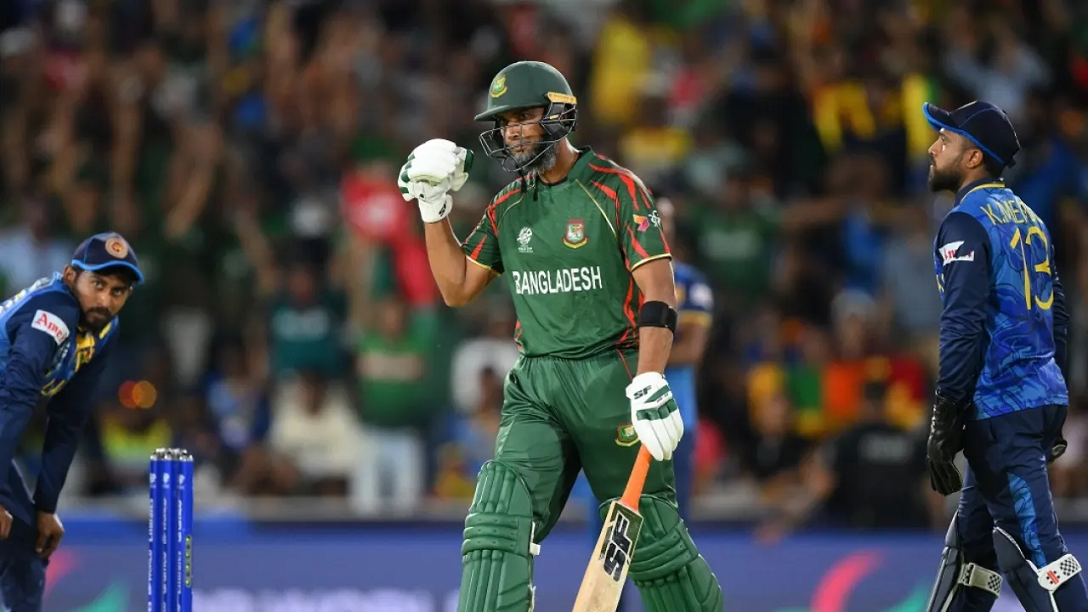
Nuwan Thushara’s last over brought Sri Lanka screaming back into the match,as he first bowled Rishad Hossain, and then nailed Taskin Ahmed in front of the stumps with a pinpoint swinging yorker. This left Bangladesh eight wickets down, with 12 runs still to get.
However, the experienced Mahmudullah was at the crease for Bangladesh, and despite some further nervy moments, pushed Bangladesh across the line off the last ball of the 19th over.
But this was a match chiefly decided by Bangladesh’s own outstanding bowling. Mustafizur Rahman was the best among them, using shorter lengths and his cutters efficiently, to claim figures of 3 for 17. Rishad Hossain’s three-for through the middle overs also kept Sri Lanka quiet.
Mustafizur was instrumental in Sri Lanka’s downward spiral through the middle overs, which culminated in a crash-and-burn end. Ultimately, their inability to find boundaries, or even rotate strike against good Bangladesh bowling resulted in their downfall. A score of 125 for 9 always seemed poor on a decent pitch, even if their bowlers made a match of it in the end.
Brief scores:
Bangladesh 125 for 8 in 19 overs (Towhid Hridoy 40, Litton Das 36; Dhanajaya de Silva 1-11, Nuwan Thushara 4-18, Wanidu Hasaranga 2-32, Matheesha Pathirana 1-27) beat Sri Lanka124 for 9 in 20 overs (Pathum Nissanka 47, Dhananjaya de Silva 21; Tanzim Hasan Sakib 1-24, Taskin Ahmed 2-25, Mustafizur Rahman 3-17, Rishad Hossain 3-22) by two wickets
[Cricinfo]


